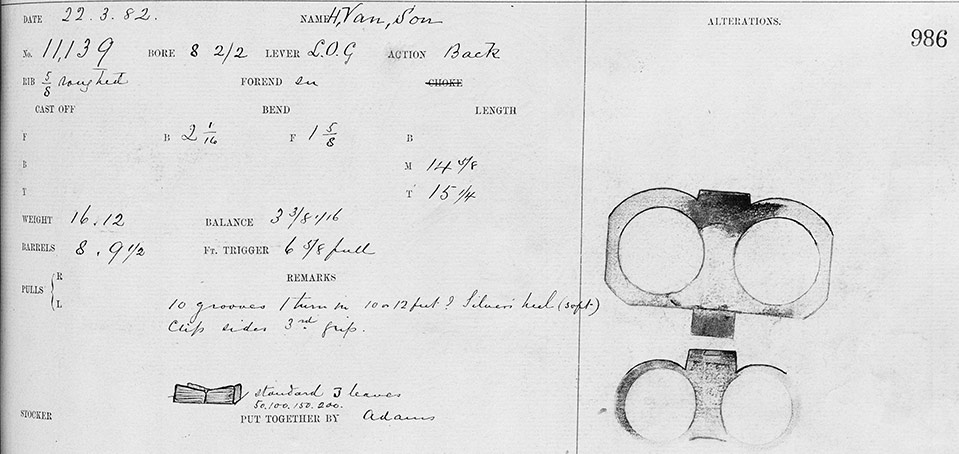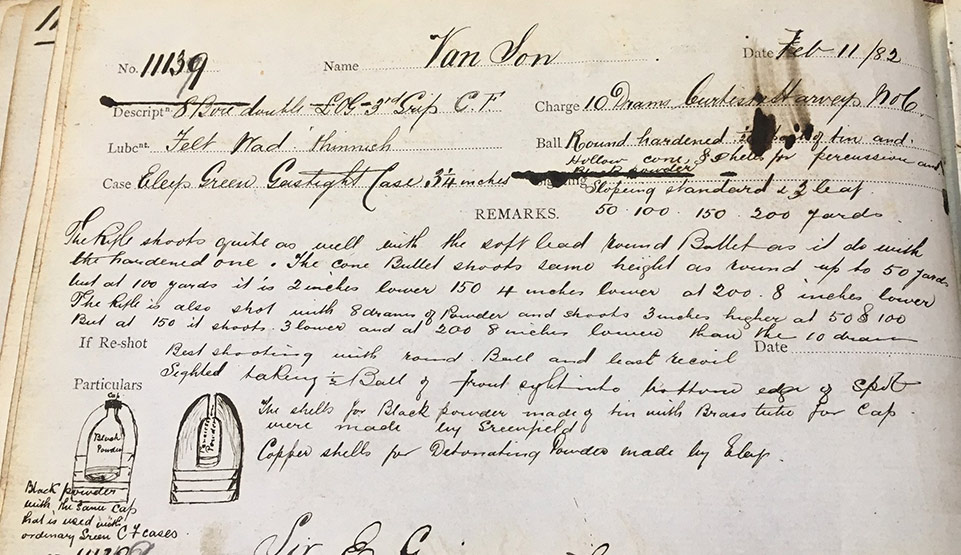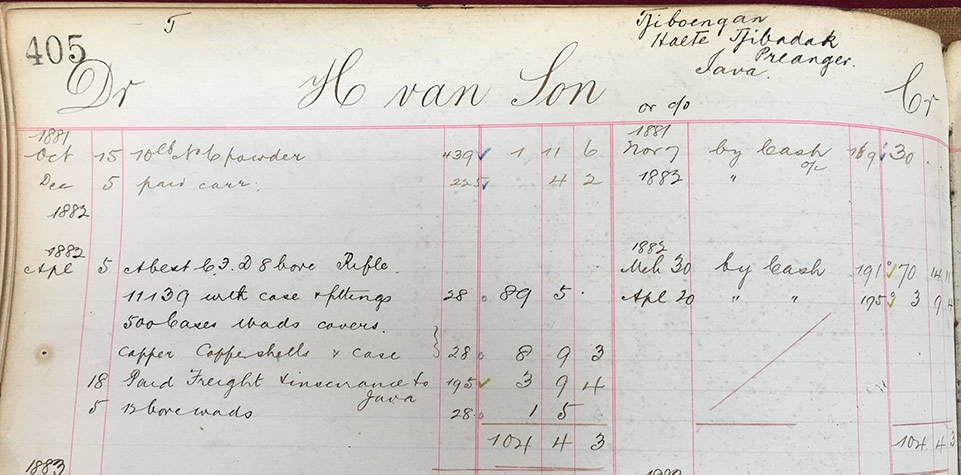Whilst Purdey is better known for its shotguns, the company has been building rifles since its earliest days. The original James Purdey fitted the first telescope-sights to both a rifle and a pistol for their inventor, Lieutenant Davidson, in 1842.
By the 1880s it is not unknown to find Purdey hammerless double rifles fitted with Davidson ‘scopes, beautifully damascened and numbered to the individual rifle. Such rifles were most commonly chambered in .450 (B.P.E.), for deer-stalking in the Highlands before the introduction of bolt-action rifles. However, every now and then a somewhat larger rifle was required.
In Purdey’s 1885 catalogue, there is a reference to “Large Bore Double and Single Rifles, of great power, for Big Game,” which could be supplied in 4, 8, 10, and 12-bore. Eighteen large-bore rifles can be found in the regulation ledgers between 1873 and 1887, although none of these are 4-bores. The largest encountered is actually a 6-bore, No. 9856, built in 1878 for the Marquess of Ripon. With the exception of this outlier, 8-bore appears to be the largest calibre rifle built with any frequency by the company during the black powder period. Of the seven listed in the regulation books, five were “Best” rifles, and the other two “C Quality”, although by 1885 the company only listed the price of the latter in their catalogue.
Eighteen large-bore rifles can be found in the regulation ledgers between 1873 and 1887
One particular entry, for No. 11139, is eye-catching due to the sheer level of detail in the records relating to its ammunition. The rifle in question was completed on 22nd March 1882 as a “Best” rifle, with rebounding backlocks and “lever-over-guard” (Purdey’s term for Jones rotary-underlevers). The action is noted as fitted with clip-sides and a third grip, although the latter is not evident on the smoke black of the breech-face that was stamped alongside the entry. The 26in. Damascus barrels were rifled with “10 grooves [making] 1 turn in 10 or 12 feet?”(sic), a very slow rate of twist by modern standards. The rib which was fitted with a 50-yard standard sight, and three further folding leaves sighted out to 200 yards. Given the size of the cartridge it fired, it is perhaps not surprising that it weighed in at a mighty 16lbs. 12oz. (of which the barrels alone weighed 8lbs. 9½oz.), and a ‘soft’ Silver’s recoil-pad was fitted to the stock.

The need for the weight and the recoil-pad becomes obvious in the regulation data. The 3¼in. “Eley’s Green Gastight Case” was loaded with a maximum of 10 drams of Curtis & Harvey’s No. 6 black powder – more than three times the average load of a 12-bore shotgun cartridge. This is also the largest load recorded for any of the 8-bore rifles, with all but one other regulated for either 7 or 8 drams. The rifle was shot with both a round and a conical ball, made from lead hardened with 1/20 part of tin. Perhaps unsurprisingly, the round ball both shot best and produced the least recoil.

The sighting notes give a good idea of the trajectories of such a large bullet. The round lead ball shot very well, and had the same trajectory as the conical ball out to 50 yards. Beyond that distance the conical ball’s trajectory decayed far more rapidly, striking 8 inches below the point of aim by the time it reached 200 yards. Reducing the charge to 8 drams produced a higher strike point at 50 & 100 yards, but then rapidly dropped off again at 150 and 200 yards.
The conical ball’s impact was amplified due to its unusual construction. The bullet had an internal cavity filled with explosive powder, and the regulation ledger has sketches of two designs. One has a large chamber, filled with black powder, with a primer cap in the tip of the bullet. These used a tin shell, supplied by Greenfields, which was fitted into the mould for the lead to form around. A primer was seated in a brass tube at the nose end, which was ‘the same cap that is used with ordinary green CF cases’. The second bullet used a smaller copper shell, made by Eley, which held a charge of detonating powder. The explosive effect of either would have been greater than even the most effective modern expanding bullet. But who would require such a rifle?

The client accounts reveal that No. 11139 was sold on 5th April 1882 to Mr. H. van Son, a pioneer of the tea trade in Java, where with J.C. van Son he founded four plantations, one of which was “Tjiboengoer”, the destination of the rifle. The cost for the rifle, including case and fittings, was £89 5s; £24 more than a “Best” 12-bore hammerless gun of the period. The components for reloading 500 cartridges were supplied at an additional £8 9s 3d, and freight and insurance to Java cost £3 9s 4d. Unlike many of his contemporaries, there is little evidence from his account that he had any interest in shotguns. His purchases in the following years included a .45 Colt “Frontier” revolver, two .577 Express rifles (Nos. 11832 and 12317), and another 8-bore double rifle (No. 12371), which although regulated for the same charge has no mention of detonating bullets.
What Mr. van Son intended to use these rifles on is unfortunately a matter of conjecture, but it seems most likely they were for use around his plantations to protect his crops of tea. Sadly, other than his role in creating the ‘Tea Expert Bureau’, opened in 1905, very little else is known about the owner of what is surely one of the most remarkable Purdey double rifles of any period. It also appears that the reason behind his usage of detonating bullets, seemingly the only occasion in the company’s history where such munitions were made, will remain equally enigmatic.
Published by Vintage Guns Ltd on




